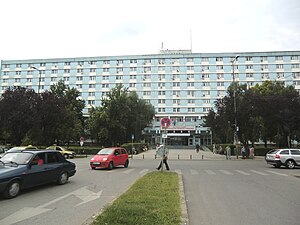Timișoara District Hospital for Emergency Medicine
| Timișoara District Hospital for Emergency Medicine | |
|---|---|
| Sponsorship | County Council Timiș (Romanian: Consiliul Județean Timiș ) |
| place | Timișoara |
| state | Timiș County |
| Country | Romania |
| Coordinates | 45 ° 44 '14 " N , 21 ° 14' 34" E |
| Clinic director | Conf. Dr. Florin Bîrsăşteanu |
| beds | 1030 |
| areas of expertise | Anesthesia , intensive therapy , surgery , hematology , internal medicine , emergency room , radiotherapy , physiology , nuclear medicine , allergology , radiology , hemodialysis , urology , metabolic disease , neurosurgery , neurology , endocrinology , occupational medicine , blood bank , forensic medicine |
| founding | 1974 |
| Website | Spitalul Clinic Judeţean de Urgenţă Timişoara |
The District Hospital for Emergency Medicine Timişoara ( Romanian Spitalul Clinic Judeţean de Urgenta Timisoara ; popularly District Hospital ) was founded in 1974 as the first county hospital (Romanian: Spitalul Clinic Judeţean no. 1 ) and as a central university hospital in Timisoara founded and is still the largest and most modern hospital in Timiș County and Western Romania .
history
The steady population growth in the 1960s had made it necessary to build a new, modern hospital in Timișoara. In 1970 it was decided to build a nine-story central university hospital. Between 1970 and 1974 the new district hospital was built in the new Calea Girocului area, the largest and most modern hospital in western Romania.
The co-founder and first director of the district hospital was Ferdinand Nistor-Gallo , one of the greatest sponsors of the Banat health system . As director of the district hospital, he set up the first dialysis ward and carried out the first kidney transplant in Romania. The county hospital also runs a school for training medical staff.
1970s
After the handover, the hospital had the following structure:
- The administrative offices of the clinic and the district health department as well as the emergency room were housed on the ground floor .
- All laboratories were set up on the first floor : the central laboratory (director Nicolae Dragomir ), the physiology laboratory (director Franz Schneider ), the laboratory for nuclear medicine (director Geza Deutsch ) and allergology (director Ion Dinu ), for radiology (director Nicolae Mărgineanu ) and the Hemodialysis (Director Ovidiu Golea ).
- The Clinic for Anesthesia and Intensive Care Therapy (AIT) with 47 beds (Director Aurel Mogoșan ) was on the second floor
- The first surgical clinic with 100 beds (Director Pius Brânzeu ) was set up on the third floor .
- The second surgical clinic with 100 beds (director Constantin Caloghera ) is on the fourth floor .
- The urology clinic with 100 beds (director Alexander Branco Stefanovici ) is on the fifth floor .
- On the sixth floor, two clinics with 50 beds each were set up for metabolic diseases (director Gheorghe Băcanu ) and neurosurgery (director Vasile Miclăuş ).
- The first medical clinic with 100 beds (director Ștefan Gavrilescu ) is on the seventh floor .
- The second medical clinic with 100 beds (director Constantin Zosin ) is on the eighth floor .
- On the ninth floor, the Neurology Clinic with 76 beds (Director Alexandru Sofletea ) and the Endocrinology Clinic with 24 beds (Director Aurel Popescu )
- The department for occupational medicine , the blood bank and forensic medicine were set up in the two outbuildings .
- A second rescue station and the kitchen with canteen were located on the courtyard.
1980s
In the 1980s, the first kidney transplant in Romania was carried out in the district hospital , endoscopy was introduced in urology and in the gastrointestinal tract , and the implantation of pacemakers was further developed.
1990s
In the 1990s, computed tomography , ultrasound examination and video endoscopy were introduced in the district hospital.
2000s
In the 2000s, the district hospital received new departments according to the latest EU standards through the new orthopedic clinics and the casualty hospital Casa Austria .
2010s
Through the affiliation of the Department of Obstetrics and Gynecology Bega , the Department of Psychyiatrie , the Department of Sports Medicine and the students outpatient clinic that was built in the 2010s Circle Clinic for Emergency Medicine Timişoara ( Romanian Spitalul Clinic de Urgenta Judeţean Timişoara ).
In 2012 the district clinic received a new, modern intensive care unit . This comprises 16 rooms with two beds each. Two rooms are each equipped with a bed. Around two million euros have been invested in the new intensive care unit over ten years. The Timiș County Council provided one million euros , the rest of the money came from private donors or from various charity events . A total of 30 patients can be treated simultaneously in the new intensive care unit. A further twelve patients can be accommodated in special rooms in the operating theaters .
See also
literature
- Thomas Breier: The history of medicine Temeswars 1718–1990. Schrobenhausen 2003
Web links
- www.hosptm.ro , Spitalul Clinic Județean de Urgență Timișoara
Individual evidence
- ↑ Petre Iliesu: Timisoara. History of a European City. Planetarium Verlag, Timișoara 2005, ISBN 973-97327-4-7
- ^ A b Thomas Breier: The history of medicine Temeswars 1718–1990. Schrobenhausen 2003
- ↑ a b c www.hosptm.ro , Istoria Spitalului Clinic Judetean Timisoara
- ↑ adz.ro , ADZ , Ana Sălişte: Freshness treatment for the intensive care unit in the Timisoara district hospital
